View current page
...more recent posts
This month's Bookforum has two--count'em, two--Serious Novelists sneering at the French for liking "bad" American writers. John Banville looks down at "enfant terrible" Michel Houllebecq's infatuation with H. P. Lovecraft and Gary Indiana can't believe a writer as great as Emmanuele Carrere (accent grave over the first e rejected by my browser) likes Philip K. Dick. This is in two different articles, mind you. Well, get over it, you losers. Much as it disgusts you, those unsavory recluses had what the first George Bush called the "vision thing," which (respectively posthumously and belatedly) caught the popular imagination (especially filmmakers'), while few outside of the editorial offices of Bookforum, where the flame of genteel writing is perpetually kept burning, know who John Banville and Gary Indiana are. I swear, sometimes I think the literary clique exists only to bash H. P. Lovecraft and Philip K. Dick. They've clearly run out of other things to write about.
(Lovecraft is on the cover, by the way--he sucks but sells magazines. "Enfant terrible" is the headline writer's phrase; I don't think Banville actually uses it.)
"Procession (Cooked)" [mp3 removed]
This is the tune I posted previously with more fleshed out (slap) bass and some atmospheric sweeps. The mood is a bit eerier and the bass drum quite insistent as befits a marching band of otter-like creatures in LED-mesh raiments moving slowly through the streets after ketamine has been dumped in the village water supply.
 | 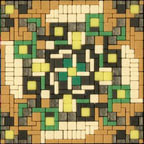 | 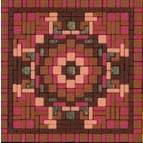 |
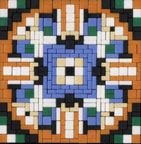 | 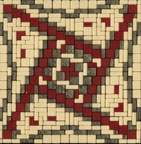 |  |

| 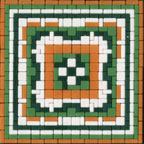
| 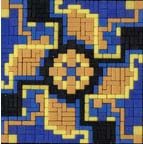 |
Update: The DVD scan collection is still going strong but the ministeck patterns have been removed. What happened? No lawyer threats, I hope. The page now identifies its creator as Stacia Yeapanis, artist and curator of the DVD museum.
"Procession (Raw)" [mp3 removed]
This is a bare bones version of a tune I'm working on. I've since moved it along several stages, adding more instruments and a bit more elaborate drumming than this lone, slightly hamhanded tom, but this draft has its charms. A sort of folk processional (why does everything I write end up sounding Irish? some deep genetic roots I didn't know I had?) is played on a very flatulent sounding Sidstation, then repeats with some bright house-y chords with a sampled Absynth.
I'm teaching myself to write in Cubase and it's painfully slow because it's not as intuitive as Harmony Assistant, the other program I've been using, or my old Mac. The scheme relies more on key commands and shortcuts that you only learn by accident, or belatedly discover buried in the fine print of the manual. Ultimately the advantage will be more control over more instruments, being able to mix midi and sound files, and having access to some of the juicy plugins that are out there. (Again--I would never talk this way about Photoshop filters: I think music engineers "get it" better than art engineers.)
This week, dear diary, I've learned: (1) how to reset Kontakt to reduce latency (note lag); it's still not 100% but is vastly improved; (2) how to trigger a 120 bpm sampled beat so it plays in sync with a midi part (after some experimentation, I reset the tempo track to 122 bpm and added a triggering note every four beats, which is the length of the sample); (3) how to sync the Sid with an external midi clock; (4) how to turn off program changes in the Korg I'm using as a midi controller, so the Sid's presets don't keep switching as I dial around the Korg. I'm also getting a better handle on bending notes with the Korg's filter knobs.
Bonus: "Procession (Panning Wah-Wah Organ Version)" [mp3 removed]
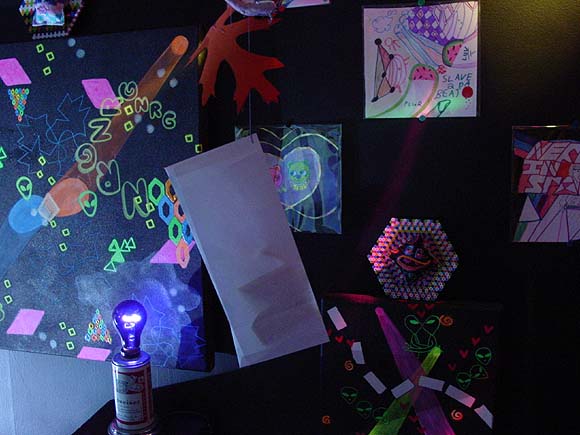

Images from Frankie Martin's installation "One Minute Rave," at Canada. Press a button outside a cloth-draped doorway, enter the room with the black light, strobe, and cardboard cutout DJ, and you have exactly one minute to freak out. Actually you can do it multiple times, but you have to keep sticking your hand outside the doorjamb to hit the switch that activates the music and lights. Some very nice handcrafted work, geometric patterns, psychedelic drawing, and pure kitsch from the era of smart drinks, glow in the dark whistles, and floor shattering bass lines. Which is still going on in many parts of the country, and/or in a state of being perpetually revived, as the '60s psychedelic thing continues to morph with new technology and new crops of initiates. The vibe might also be "the early years of rave" before the DIY spirit gave over to corporate interests, if that era ever in fact existed. Maybe it's just an ideal rave of the mind. To put it in some historical context, this was to the early '90s what Kenny Scharf's black light rooms were to the late '60s, but less sardonic and more girly--and I mean the latter in a good way. It's truer to the spirit of the show than saying "post-feminist" and it's certainly not grrr-ly.
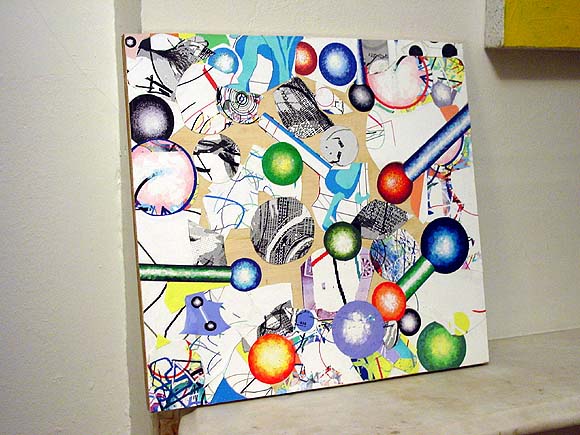
Momenta Art in Williamsburg has its annual benefit coming up and I'm donating a piece. Jeez, the last time I did this was four years ago, shortly after I started this blog. Here's to both of us still being around in the world o'ephemera that is the art scene. I tried something new with the piece above, which is gluing the paper--many little cut out pieces printed with "drawn elements" from my home computer--directly onto a piece of plywood. I was expecting to struggle more but this came together fairly quickly--I'm happy not to drag out the process. Now, if I was Fred Tomaselli I'd collector-ify the piece by pouring polyurethane goo all over it, but I kind of hate that restaurant table decoupage look so I think I'll just give it a light coat of matte fixative and call it done. I like seeing the texture of the paper clinging to the wood--I also left some wood showing on the front, which I didn't expect to do. All this could change tomorrow but I only have a few more days to screw with it.
Tom DeLay Is Declasse
The New York Times tastefully summarized a recent paranoid speech by Tom DeLay, the former bug exterminator who was "mad about gummint regulation" and pretty much took over the US House of Representatives. Investigations are finally closing in on him so he's been desperately demagoguing on the "right not to die" issue. Here's more of his speech to the Family Research Council:
And so it’s bigger than any one of us, and we have to do everything that is in our power to save Terri Schiavo and anybody else that may be in this kind of position.The residents of DeLay's Congressional district--Missouri City, Sugarland, Rosenberg, Texas--may be happy to have someone in Congress making speeches like this. (I like to think the people I know from there aren't so simplistic.) But he doesn't just represent a minority bloc of home-schooled Christians, he has been the main power in the House since the late '90s, largely by turning on and off a spigot of corporate cash. What I don't get is how somewhat more urbane, well-educated Congressmen, Hill staffers, even smooth corporate lobbyist types, let this creature gain so much control. It recalls the rise of Joe McCarthy--there's something inherently weak in our Congressional system that allows ign'ant monsters to flourish. The good news is the poll numbers are overwhelming against DeLay on the Schiavo issue. We should all pray to Beelzebub and Madelyn Murray O'Hair that his reign will soon be ending. (Hat tip to mark for the speech link--there's also video but I don't think I can stand to watch it.)
And let me just finish with this: This is exactly the issue that’s going on in America. That attacks against the conservative movement, against me, and against many others. The point is, it’s, the other side has figured out how to win and defeat the conservative movement. And that is to go after people, personally charge them with frivolous charges, and link that up with all these do-gooder organizations funded by George Soros, and then, and then get the national media on their side. That whole syndicate that they have going on right now is for one purpose and one purpose only and that’s to destroy the conservative movement. It’s to destroy conservative leaders and it’s, uh, not just in elected office but leading. I mean Ed Feulner, today at the Heritage Foundation, was under attack in the National Journal. I mean they, they, this is a huge nationwide concerted effort to destroy everything we believe in, and, and you need to look at this and what’s going on and participate in fighting back.
Don’t, you know, the one way they stopped churches from getting into politics was Lyndon Johnson, who passed a law that said you couldn’t get in politics or you’re going to lose your tax exempt status because they were all opposed to him when he was running for president. [And before that, the US Constitution, which mandates separation of church and state.] That law we’re trying to repeal; it’s very difficult to do that. But the point is, is when they can knock out a leader then no other leader will step forward for awhile because they don’t want to go through the same thing. When, if they go after and get a pastor then other pastors shrink from what they should be doing. It forces Christians back into the church and that’s what’s going on in America: “The world is too bad. I’m going to go get inside this building and I’m not going to play in the world.” Uh, that’s not what Christ asked us to do. And, and so this, they understand that it is a political maneuver, and, and they are, uh, going to try to destroy the conservative movement and we have to fight back. [Just a reminder: the "conservative movement" controls all three branches of government plus the press.]
So, please, this afternoon, each and every one of you, if you know a senator give him a call. Tell him, they’ll say, “Our bill can pass in the House.” Tell him, “That’s fine. Your bill’s okay but the House bill is better and, uh, I want the House bill.” Particularly if you know Democrats, uh, don’t let them get off the hook, um, by hiding behind one House and the other is adjourned. We can do anything we need to do to pass any bill that we need to pass. So I appreciate what you’re doing. God bless you and thank you for the Family Research Council.
"House Classics for Solo Organ" [mp3 removed]
"Very Short Rave" [mp3 removed]
The latter is not to be confused with Frankie Martin's exhibition "One Minute Rave" at Canada, which I haven't seen yet. She has produced a seven-inch vinyl record of rave tunes lasting one minute. Mine clocks in at 1.5 but I promise you this is hot.
From the movie One Hour Photo: stalker/artist Robin Williams contemplates his family snapshots. Ten years of the Yorkin family, all palmed at the photomat where he works:

As I recall, Joe Bob Briggs called Tom Noonan in Manhunter "the only psycho with a full time art director." Move over, Tom.
This comes up because we've been discussing the "Mapping Sitting" show at the Grey Art Gallery. Two contemporary artists, Walid Raad and Akram Zaatari, working solidly in the Western post-colonial/conceptualist mode, present hundreds of photos made by a Lebanese commercial photography studio from roughly 1950-1990. This is supposed to repair Western ignorance of the real Middle East*--presumably all at one gulp. Bill says the grid reminds him of the freshman class pictures in the National Lampoon high school yearbook, which were reproduced so small no one could see them. I thought of Robin Williams' masterpiece in One Hour Photo. The grid at the Grey sure looks arty from the installation shot--the artists (one based in Beirut and one in NY/Beirut) appear to have captured, appropriated, and neutralized all this historical commercial (i.e. non art) work with their eye-boggling grid. Also colonized it in the sense of taking it over and presenting it as their own (nothing wrong with that but let's get it on the table), and exoticized it in the sense of why are we having this show if it isn't about consuming "non-Western" experience. I realize I'm critiquing an installation shot--maybe the actual work is more meaningful.**
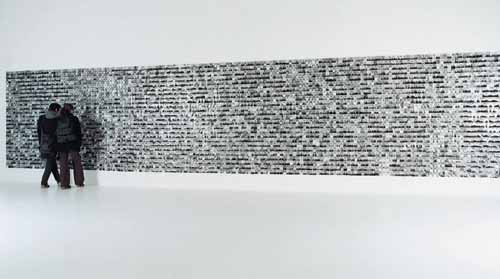
*From the website: "Collectively, the images convey the pluralistic and multifaceted communities captured by indigenous photographers—images far different from photos of the region circulating widely in the popular press today. In Mapping Sitting, Raad and Zaatari reveal how Arab portrait photography not only pictured individuals and groups, but also functioned as commodity, luxury item, and adornment. Concentrating on commercial images, the exhibition not only raises questions about portrait photography in the Middle East, but also about portraiture, photography, and visual culture in general."
**Update: toc says in the comments: "with his work as 'the atlas group' raad often works with 'historical' documents that he creates himself, rather than true objets trouvés. an installation of automobile motors left over from car bombings in beirut is really just a collection of whatever motors raad can find in the city hosting the exhibition. i haven't seen 'mapping sitting', but i suspect there's something more going on than the worthy politics/august sander ethnography that is presented in the marketing materials." It would certainly be more interesting if the Lebanese portrait studio turned out to be fiction but somehow I don't see NYU (Grey) participating in a hoax. If anyone knows the real story I'll be happy to post it.
From Paul Slocum:
I made a couple of new things for the show, these circuit board pieces. I found a way to translate bitmap images into the circuit design program I was using, and converted actual and recreated images that I had made in elementary and jr. high school. The drawings are rendered in tin-plated copper on standard circuit board material. And the drawings are integrated with very simple circuits that illuminate LEDs and a neon lamp.
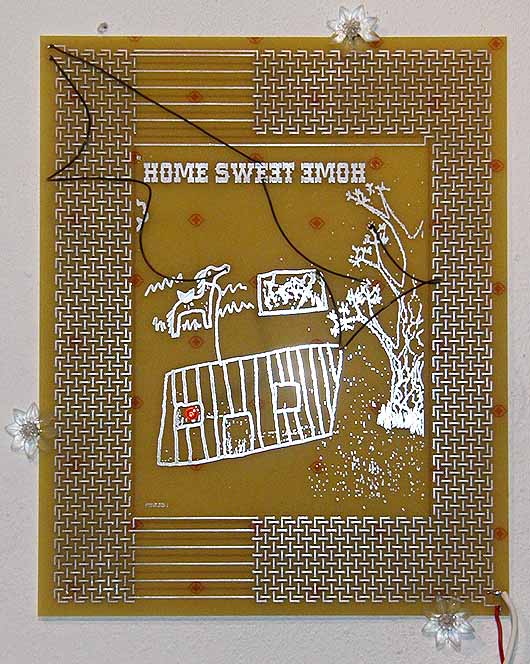
As I've mentioned a few times, I recently acquired jenghizkhan's Sidstation synthesizer, which incorporates a working vintage sound chip from the Commodore 64, the "legendary" home computer used by many geeks and/or gamers in the '80s. The Swedish company Elektron built only about a 1000 Sidstations due to a limited supply of the chips--it recently found another 100 and the machines were sold just like that. A Macintosh SE user back in the day, I have no attachment to the Commodore and am actually not that interested in recreating game sounds per se, but I am intrigued by the manufacturer's claim that the hacker community explored every permutation and limitation of the chip's sound-making potential, or words to that effect. How many products can you say that about? And in any case, the Sidstation is more than just a chip, it's a full blown synth with many levels of programming and some incredibly interesting full bodied, but all fairly dirty and noisy, sounds.
I'm taking my time about plunging into the inner mysteries of this instrument. Changes to presets or "patches" are done on a tiny LCD screen--with only slightly more characters than a cell phone. I've been exploring the patches that came with it, changing settings and sounds with the machine's few knobs and running various sounds and MIDI files (including my tunes) through it--all the while teaching myself more about the rudiments of synthesis from books, as well as some other hardware with more buttons to push and dials to turn. Also, I've been nervous about crashing it and not knowing what to do next. jenghiz sold it to me with about 90 presets and a CD that I thought had only back-up files. I was a little disappointed that so many of the patches were sequences--i.e., someone else's tunes that you could use like an arpeggiator to play under, or triggered by, your own melodies.
Getting to the point of my story, I crashed the machine the other night. The patch database was completely locked up, so I had to erase all the presets. I downloaded MIDI-OX, which is a MIDI file managing program, to my PC and opened up the CD. Lo and behold, there were several hundred more patches on the CD I didn't even know I had. I successfully did a MIDI dump and reloaded the Sid with about 90 new voices, most of which are not sequences! It feels like Christmas around here. I know the hackers are laughing but give me my simple pleasures. Eventually I'll have my real rite of passage and start seriously tweaking these patches.

For a later time: why are sounds so much more interesting to me than all the colors and textures of Photoshop, et al? I've gone deeper into sound technology in the past six months than I've gone in years of working with imaging software. With the latter I always felt (and still feel) like I could do everything I wanted to do with just the rudiments: 256 colors and a few basic tools.
Oh, hell, I'll go ahead and attempt to answer this. First, I can draw and paint pretty well (I'm about to choke on this modesty) so I don't feel I need the tech to augment my skills, whereas I am only an adequately dextrous musician and thus more dependent on the tech to make music I can hear but not necessarily play. (Just for the record: hand skill is not a requisite for any art but might have a bearing on relative levels of confidence or cockiness.) But I think even more important than the dexterity issue, electronic music hooks me more on a gut, emotional level than electronic art: I prefer it more as a consumer and am therefore more willing to learn about it as a producer. Ouch, I said it. But then, I've cycled back and forth between dj'ing/music crit and studio art/crit since college days so this is probably just a phase. OK, that's about all the autobiography this blog can stand.
"The Star Pools" [4.2 MB .mp3]
Announcing the "Thomas Gradgrind Award"
This week's Gradgrind goes to Michael Kimmelman of the New York Times, for the last paragraph of his "Greater New York 2005" review:
It's good, in this context, to find a selection of Steve Mumford's painted dispatches from Iraq, plainspoken journalistic pictures of a throwback kind. They announce a mature artist looking closely at what is urgently unfolding around him. Their traditional sobriety stands out in a show that, like the burbling young art world now, seems gladly co-opted and almost too able to please.Top hole, Mr. Kimmelman. Top hole. Our lady Queen Victoria would be most impressed, Indeed, one wishes to see young artists be mature and perspicacious in their craft and not susceptible to influences of the fleeting and trivial sort. And all the better if the illustration in question is in the illustrious service of the Empire, what ho? (Tip of the top hat to bill for finding this most stout and exemplary paragraph.)
Another "Greater New York" (2000) alum: Nina Katchadourian
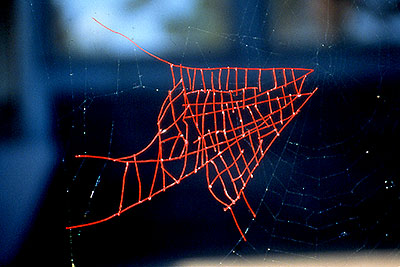
Nina Katchadourian at Debs & Co., New York, NY
by Tom Moody
("Author's cut" of a review originally published in Artforum, Summer 1999)
Nina Katchadourian's recent work, documented in photographs and videotapes, consists of trivial or inept "repairs" to flora and fauna, suggesting the efforts of a clueless amateur field biologist. In Renovated Mushroom (Tip-Top Tire Rubber Patch Kit) (all works 1998), the naturally occurring cracks on mushroom surfaces have been fixed with multicolored tire patches, converting the caps into ridiculous-looking polka-dotted tuffets; in Transplant, a plant's missing leaves have been replaced with membranous insect wings, restoring its symmetry but turning it into a part-animal, part-vegetable monstrosity. Combining the callous experimentation of H. G. Wells's Dr. Moreau with the suburban puttering of Martha Stewart, these projects also send up Andy Goldsworthy's intricate arrangements of rocks and leaves in arcadian settings, which use shamanistic ritual as a pretext for lush photographic set-ups.
Especially reminiscent of Goldsworthy was the "Mended Spiderweb" series, for which Katchadourian sought to restore incomplete areas of large outdoor webs (these were often not the result of any damage but simply gaps in the overall pattern left by the spiders for their own mysterious reasons). Using tweezers and glue, she introduced individual strands of starched bright red thread into a web. The resulting crisscrosses of thick red lines loosely continue the web's pattern, but the photographs make clear that what began as links between interrupted strands often took on lives of their own, seeming to float in the air as "drawings"--semi-abstract, Paul Klee-like pictograms. Mended Spiderweb #8 (Fish-Shaped Patch) really does look like a fish, and certain breaks in the web's network of strands were obviously left "unmended" so that these contours might be retained. Mended Spiderweb #19 (Laundry Line), with its glowing arc of hieroglyphics spanning two webs, features more instances of selective repair. Hovering in gossamer filaments, these thread works are a fragile pas de deux of human and natural effort, so compelling they almost don't need their tongue-in-cheek backstory of "web repair."
Whether one sees them as ironic gestures or exquisite drawings in their own right, the works in this series are tactless invasions of the spider's domain, a fact that Katchadourian readily admits in an accompanying catalogue essay. "I often caused further damage," she writes, "when the tweezers got tangled in the web or when my hands brushed up against it by accident." And while we normally don't know how nature feels about human attempts to "help" it, Katchadourian got immediate feedback. The morning after she made her first patch, she found the threads lying on the ground and realized to her surprise that the spider had pitched them out of the web during the night, like a body rejecting a transplant. This continued to happen with subsequent "repair" jobs, and she eventually succeeded in capturing the rejection process on tape. In the ten-minute video GIFT/GIFT, the viewer watches in amusement as a spider scurries around its web, removing threads as quickly as the artist inserts them. If one sees Katchadourian's project as a kind of New Age-y drawing, then the arachnids become happy collaborators in a cycle of creating and wiping the slate clean; if you take the work ironically, they're environmental "victims" who don't need the help, thanks. It all depends on how you spin it.
Above: Nina Katchadourian, Mended Spiderweb #8 (Fish-Shaped Patch) (detail), 1998, C-print, 20" X 20"
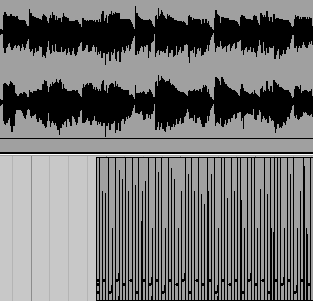
"The Elect Tribe" [mp3 removed].
A catchy Korg drum-and-bass melody interpreted in a dark, psychedelified electro fashion with enthusiastic drumming by a friend's nephew.
Still Emerging After All These Years
With MOMA/PS1's "Greater New York, the Return" we are once again faced with that slippery concept of when an artist "emerges," which leads to oddities such as Scott Grodesky emerging twice in the pages in Artforum, in 1992 and then 12 years later. Why are we faced with this issue? Because "emergence since 2000" and "working in the New York area" are the only stated themes for the show. Important, career launching exhibitions used to have core ideas, reflected in titles such as "Primary Structures," Douglas Crimp's "Pictures," and "The Intrasubjectives"--OK, the latter isn't exactly on anyone's lips but the show included the major AbEx'ers. But since all the powerhouse academics have fled the artworld after using it as a seedbed for pet sociological theories in the '80s and '90s and ultimately killing the soil, and quirky individualism at the curatorial level isn't tolerated in the US anymore for a variety of political reasons, what we get are full time functionaries working in teams, and the only thing they can all agree on is geography and the date.
Yet arguably they botched even the latter, since one could make a strong case that all of the following GNY2005 artists emerged in the '90s and not the 2000-2005 period: Michelle Segre (Elizabeth Koury project room in '93 and Roberta Smith-reviewed two-person show at Lauren Wittels in '96), Randy Wray (solo at Kagan Martos in '96), Meredith Danluck (Andrew Kreps '97), Jason Fox (Feature '99 and group shows starting in '90), Robert Melee (Kreps '98, White Columns White Room '95), Wade Guyton (Kreps project room '99--yes, this one's a squeaker). Corey McCorkle, Steve Mumford, and Sue de Beer were also showing quite a bit in the late '90s. Whether or not the artists had solos or project rooms, all of the above were in group shows and many were written about in not very obscure publications such as Artforum and the New York Times. The upshot of all this isn't that it's unfair for curators to stretch an artist's period of emergence (and I know and/or have written about many of these artists and am happy they're still emerging) but that emergence as a criterion for a major museum exhibit is stupid and should be retired.
"Greater New York" alum: Jesse Bransford
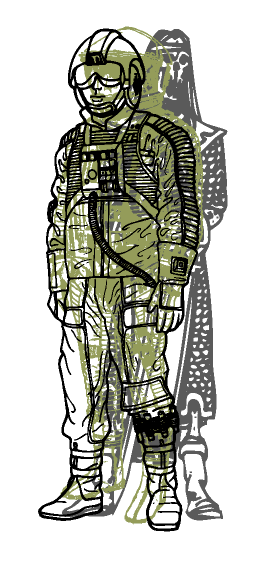
Continuing an impromptu, on and off series highlighting artists from "Greater New York" (2000), in the "subversive just-past" spirit of this press report. Above, a 2001 image by Jesse Bransford titled Hero; below, an anamorphic drawing from his show last year at Feature. In the '90s Bransford mixed Patrick Stewart, Marshall Herff Applewhite, and various Excelsior and/or Constitution-class Federation starships in with his dense layerings of medieval imagery and cabalistic diagrams, and the pop culture element was missed in the 2004 exhibit, which was technically polished and almost willfully mature. This mirror piece, however, is a tour de force: if you gotta grow up (a stretch in this culture, I know) this is the way to go.

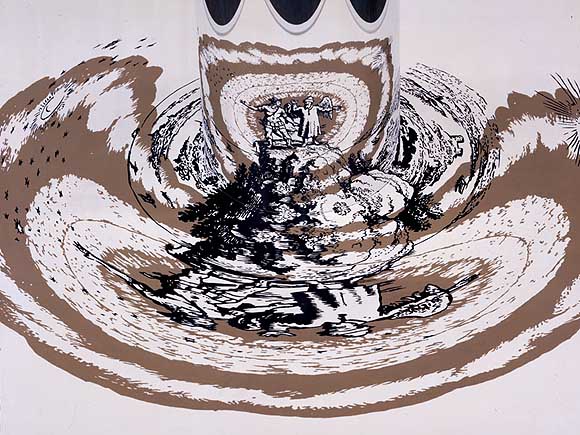
"Greater New York 2005" to Revisit Previous Group of Artists
The Museum of Modern Art's alternative space, PS1 in Queens, announced today that "Greater New York 2005" will consist entirely of artists from the 2000 exhibition "Greater New York." "We wanted to see what all our artists were doing five years later," said PS1 director Alanna Heiss, "and frankly we're sick of this 'fresh young talent' paradigm." She says she fears that New York is "becoming like LA, where the scene is centered around artists still in grad school" and protested the "increasing infantilization trend" of the rival 2004 Whitney Biennial. At an impromptu press conference, she read the following quote from a 1987 Dan Graham essay as further justification for the Museum's somewhat unexpected and daring project:
According to [Walter] Benjamin, "progress," the 19th-century scientific and ultimately capitalist myth, is expressed in commodities, fashion goods which "produce a sense of eternal newness." This makes progress a mythical goal, never to be reached, for there is always the new and it is always superseded by the next new. For Benjamin, then, progress is actually a state of stasis. And yet it is this very stasis that makes the recovery of the just-past potentially subversive.Below, images by "Greater New York" artist Michael Phelan, then and now:

Michael Phelan, from the "Driftwood and Dried Arrangements" series shown in "Greater New York" (2000)

Michael Phelan, from the "Bears" series, to be shown in "Greater New York" (2005)
I'm wondering if there is some immutable law that the size of political demonstrations increases with the distance from the reporting country. A New York Times headline today announces that "Hundreds of Thousands of Lebanese Rally Against Syria"--apparently affirming the White House propaganda that the US slaughter of Iraqis somehow caused democracy to bust out all over the Middle East. Yet when hundreds of thousands rallied in Washington and New York against Bush's planned aggression, it was reported as "tens of thousands." Also missing from the headline, but included in the body of the article, was the fact that the week before in Lebanon, a "pro-Syrian march ... also filled the downtown with hundreds of thousands of mostly Shiite demonstrators." Yet when hundreds of thousands rallied in Washington and New York for Bush's planned aggression--oh, wait, there were no such demonstrations.
UPDATE (as I'm writing this). Since it might be less than clear from the opposed nature of the huge Lebanese demonstrations that the most recent protest is a victory for Bush, the Times just changed its headline to the more helpful "Rally Against Syria Appears to Be Largest Yet in Lebanon." O-kay.
From MTAA: PS1’s website redesign sucks
How does PS1’s web site bite? Let me count the ways… rudely.Originally from MTAA Reference Resource, ReBlogged by francis on Mar 12, 2005 at 04:02 PM, Apologetic disclaimer removed by tom.
1. Splash page (need I say more?)
2. Cheese ball flash animation announcing GNY2005 [Greater New York is a kind of Whitney Biennial for New York artists, held at PS1 in Queens, the Museum of Modern Art's "alternative space." This is the second; the first, a perceived "career launcher," took place in 2000. --tm]
3. Evil pop-up from cheese ball flash animation announcing GNY2005
4. The artist list in the stupid pop-up from the cheese ball flash animation doesn’t do anything! Yes you can rollover an artist’s name and it lights up, but a click does… nothing!
5. The exhibition section just has the stinking press release? How about some friendly copy (and larger text). PLUS, the navigation of stinking press release is too small and too confusing (the page you’re on should be highlighted not the page you’re not on, duh!).
6. Why is there a ‘press’ section when the exhibition section already has the press release? Oh, I see, so you could put a really big dumb graphic that says ‘Press, Greater New York 2005’, which clicks off to MOMA’s site.
7. At least make the friggin’ top-left logo clickable back to the homepage for chrissakes! This has been web-site navigation convention from before the turn of the century!
8. It don’t validate. (snigger, snigger) And it’s so f’d up, it would be hard to figure out where to start.
9. Change your meta-tags now! NOW! NOW! NOW! (It’s a shame to see the free and open-source Mambo put to such wicked uses.)
Ahhhh. That felt good.
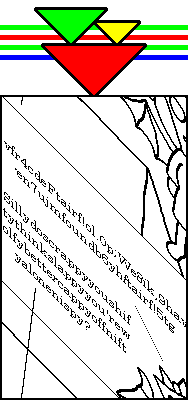
More imagery lifted (or re-lifted) from http://castlezzt.net, which Michael Bell-Smith found and which Paul Slocum describes as an "amazing mile long webzine thing" with the caveat that it's "probably not good for weak of computer or slow of internet." Go experience it yourself, it definitely poses a challenge to Abe Linkoln's complex net art diagram in the browser-busting department and is chockablock with interesting found (?) and concocted (?) imagery. (And did I mention that it's also juvenile and incoherent?) Rather than trying to recreate the experience here, I've just plucked out a couple of nuggets from the original maximalist context. Some nice new animations have recently been posted.
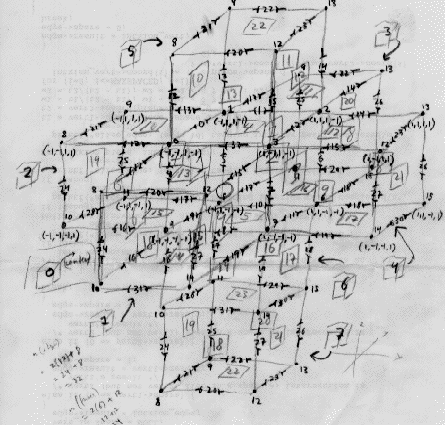
A few posts back I wrote:
Dedication to old gear and pure hacking vis a vis current proprietary software systems in some ways recalls the rock purists of yore who insisted that only black Delta blues musicians had integrity relative to British cover bands, or that 3-chord garage bands always had the edge over prog rock & fusion. This kind of essentialism has Occam's razor logic on its side but can also grow stuffy and cult-like.Modern Kicks replies here:
Point taken, and I generally agree. But with two caveats: (1) the part about 3-chord garage bands isn't really analogous to the first example, and (2) it happens to be correct. As the Mad Peck [in Creem magazine] taught us all long ago.Then I said:
Thanks for the feedback on those posts. Regarding your earlier comment, I added a parenthetical ("Was it really necessary to throw out the baby of Canterbury and electric Miles with the bilge of Kansas and Spyro Gyra?") re: the prog and fusion (or proto-fusion) I think holds up against the Pistols, etc. By "Canterbury and electric Miles" I mean Soft Machine, Tony Williams Lifetime, Can, Faust, John Cale, "Thrust"-era Herbie Hancock, Larry Coryell ca. "Live at the Village Gate," early Mothers, Fred Frith, etc etc. Also, you didn't explain what makes 3-chord rock purists different from Delta blues purists.Then MK said:
I guess my point was that prizing the integrity of black Delta blues over the British bands that covered them is to make a distinction between an original and a copy. But preferring 3-chord garage rock to prog isn't a matter of original and copy, it's choosing between two competing aesthetics. So the two comparisons work in different ways. The garage rocker doesn't dislike prog because it's a distortion of his aeshetic (as the blues aficionado does feel about, say, Led Zeppelin); he hates it because it opposes what he values.My reply to that:
I suppose one could argue that there is a similarity on the basis of a demand for some idea of authenticity on the part of the Delta blues and garage rock fan. But I'm not sure that works either. After all, many British bands insisted on attempting to maintain as high a degree of blues authenticity as possible (obviously a limited one, but nevertheless.) And garage, rather than the spontaneous expression of rock and roll it claims to be, is almost always an intellectualized, even mannered aesthetic. Not that there's anything wrong with that.
Yes, the point of similarity was (presumed) authenticity but more particularly--in the context of hackers making music vs. musicians using off-the-shelf software--the quest for a kind of musical sine qua non. Thus the reference to Occam's razor: Which is the most economical musical expression? The original or the copy? The basic or the hyper-elaborated? 1s and 0s or unnecessary proprietary code? It still seems all of a piece to me. More important, all three (blues, garage, the command line) can be cults demanding adherence to the divine orthodoxy of reduction, as against the possibility that there might actually be good British blues, good use of Reaktor, or (gasp) good prog. And the Mad Peck was wrong about Kraftwerk, they were robotoid but also funky, which is why they were playing in boomboxes all over NYC in '78, and their audiovisual minimalism was admired by many punkers.
"Groove-stricken" [mp3 removed]
[Update: Increased the volume slightly so one might be better stricken by the groove.]
"Reel for Omniverters (Final)" [mp3 removed]
"Reel for Omniverters (Beat)" [mp3 removed]
I know I keep posting this song but I'm following my original plan of adding softsynths. The so-called final version is run through an analog filter; the "beat version" is mostly a triphop-style beat with omniverter themes swirling in the background.
Double Alpen, 1995, acrylic on cereal boxes, 10" X 13" X 3"
More on failure and abuse in the digital realm, edited from a previous comment thread:
paul: I guess my point is that finding new creative ways to use software is just kinda what computer art is. Every piece of decent computer art I can think of that makes use of existing software falls into there. How can you make interesting computer art and NOT push the limits of what software was intended to do? (maybe there's a good answer to this...)
tom: I would say 99.9% of computer use to do creative work is exactly as the programmers intended, and many people consider the result art without imagining abusing their tools. Think all those hundreds of MIDI versions of pop songs, all completely obedient to the "rules." Is it "bad"? Well, yeah, most of it, but it succeeds on its own terms. This depthCore site, I don't think involves abuse on any level. They call it digital abstraction, and a lot of it's cheesy and album cover-y, but you can pick and choose and find really involved and intricate passages. Yet none of it seems to be straying outside the bounds of the programming. All that POV raytracing stuff is another example. Also some cool things there--but it's not about abuse.
[...]
paul: well anyway, I really want to abuse vocaloid.
tom: That's one I'd present straight up. It'd be hard to improve on this for sheer oddness. Another lovely, non-abusive use of the digital medium: an abstract 3-D animation set to John Coltrane's "Giant Steps" by Michal Levy (takes about a minute to load on cable, longer on dialup; hat tip to Steve)
Continuing on the subject of whether one can truly abuse digital equipment, John Parker, who makes art or experimental electro and has a very painterly approach to sound, had this comment:
A programmer for a digital instrument has to make a series of solutions to particular tasks. No matter how comprehensive the tasks, there will always be phenomena that the digital instrument makes that comes from leftfield, that was unintended, that is a 'crash'. What else could be expected from something that is made by an imperfect human being.Drx also had a follow up comment on the failure issue:
Commercial stuff is enticing for abuse because it is easy to screw with the manufacturer's original intention, [which was] to make an instrument that will appeal to a commercial market. All the interesting stuff can be found in their failings. Softsynths are a fertile resource for new digital sounds. Their many failures in trying to sound real leave behind interesting residue. Also, in a program like Reaktor, all you have to do is change parameters to unrealistic amounts or just randomly re-arrange wires to get some interesting stuff especially if it was intended to sound like a Juno 106 (that's why I like Reaktor better than MAX-MSP). Sure the sound is already there, but without a particular mindset, one would not find it.
I like your comment on failing computers. During the first shows of Bodenstandig 2000 our computers constantly crashed. The audience *always* thought this is part of the show, while we were sweating on stage to bring them back up running. For a big internet project i once did, which is changing everything you see on the web -- up to the point that the medium becomes unusable -- an estimated 99% of all users that were tested without knowing it thought that this is just the normal web.
After that i came to think that errors and crashes are just in the minds of the users and in fact in most cases you cannot distinguish a faulty and a working system. Microsoft also applies this insight in Windows XP for notifying users that a program crashed. While in earlier version you could see some honest blue screen and crazy register contents, now appears a tranquilizing dialog box saying smth like: "Powerpoint is currently in a buddhist temple. Ah, it is coming out again, see, there it is." And back comes your program, simply restarted automatically. All this on the background of a picture of grass land and clouds. k3Wl!
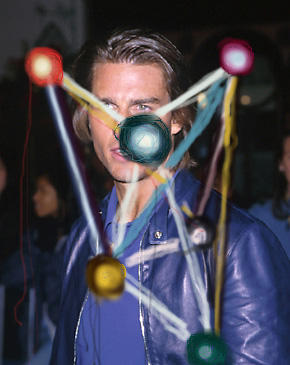
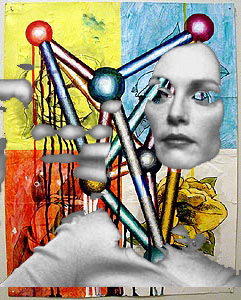
Magnolias 3. screenfull found the post facto pop culture reference in an art-for-art's-sake (or pseudoscience's sake) meditation. Speaking of the actor who shall remain nameless, this unfrozen caveman blogger just saw Rain Man for the first time. Cruise the auteur (whoops, I said it) stands, in movie after movie, for the thoroughly mediocre concept of the "heel who learns the healing power of love." Pardon us while we barf. In my version of Rain Man, Charlie wins the custody fight with the K-mart cracker doctor, hires his own minder and puts Dustin Hoffman on the payroll of what swiftly becomes a thriving commodity futures trading consultancy. Apropos of the freaky scene in the elevator, Cruise's girlfriend sleeps with both of them. Collectively, but only collectively, the Babbitt bros are Warren Buffett--individually they are just two dudes with problems.
Drx from Bodenstandig 2000 responds here to some recent bluster on this page, offering among other things a pretty fine argument that one cannot abuse commercial digital products:
The discussion about using or abusing instruments is not really fitting to digital instruments i think. You might take a saw and cut through a violin and record that, at some point in history that would have been cool and considered being an abuse of an instrument. To really abuse it you might want to drive nails in a wall with a violin and not even record that. -- But to say one is abusing digital instruments is in my opinion only a way to make yourself look cool. Abuse=Punk=h4rdc0re!! There is no such thing as turning the knobs in the wrong direction on a sampler. Not to follow the instruction manual or failing to reproduce demo songs is not abuse. It's just that after some time another sound becomes acceptable to listeners. You might consider what i do to the YM2149 chip is abuse, but in fact, thru exploiting all the things it can do, i bring it to blossom and beauty. It's all inside the machine. Maybe some things were not even considered by the constructors of the chip, but it is still there. And a sampler can just store any sound, so to put there as many different ones as possible seems natural to the materiality of the instrument. Not doing so is misunderstanding of the machine. Digital artefacts can be brought to a different context. Nintendo hardware, more closed source than anything, can be freed and brought to everybody, not only developers paying licenses. (Yes, maybe 15 years later, but still!) A chip that was intended to control the printer and make keyclick sounds can become a musical instrument. (YMROCKERZ!!) Powerpoint can be used to make art. All this is not abuse, it shows us the great potential of software. Nothing breaks, only more things appear.Thanks. As mentioned earlier, Drx represents the absolutist position, which might be summarized as:
1. Data wants to be free, except when being hoarded from frienemies in the computer music scene. (*smiley emoticon*--this addresses an earlier statement of Drx's in the same thread.)
2. As Robert Pirsig argued in Zen and the Art of Motorcycle Maintenance back in the '70s, everyone has the means to hack the machinery that controls our lives given time, patience and the right holistic frame of mind, except those who can't figure it out.
But we shouldn't be so quick to relinquish the term "abuse" when talking about what artists do to anything. Clearly a continuum exists from "Listen, I made a weird squawk" to "something the manufacturers never intended" to "total irrevocable damage to the product." Nothing breaks? Tell it to a musician friend of mine whose digital keyboard crashed during a live gig when he hit two mute keys simultaneously. He emailed the manufacturers (smart hacker dudes in a small company) and they said, "You're right, that's a bug and will be fixed in version 1.4." And the ymrockers reference reminds me of the recent New Museum group show where several screens were frozen (not theirs, and warning, dyspeptic rant). As long as computers and digital gear fail naturally, and they do all the time--they're stinky with failure--it should be possible to speak of counter-abuse coming from artists, or "use of abuse." All that said, Drx's status-quo-disrespecting statement offers a jolt of pure inspiration.
An earlier post on Drx is here. See also this discussion on whether code knowledge is relevant to making art with digital tools. Before getting sidetracked on the term "abuse" I wrote a few posts back about "undiscovered uses or misuse of products by musicians": "misuse" referred to Samuel Delany's argument in Mark Dery's Flame Wars that hiphop culture was oppositional to rather than merely consuming of "sci fi" electronic products.
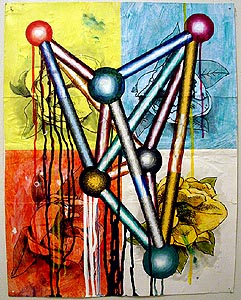
Magnolias, 1994-1996, ink, acrylic, and collage, 21.5 x 17 inches. I plan to post more historical work while going about the time-consuming business of teaching myself some new musical chops.
20 years ago Roger Corman's New World Pictures cut 30 minutes out of Hayao Miyazake's post-apocalyptic eco-fable Nausicaa of the Valley of the Wind and released it as Warriors of the Wind, with Star Wars-conscious packaging and English-sounding character names. Nausicaa--actually named for a minor Greek character in Homer--became "Princess Zandra" and the monstrous insects called Ohmu became "Gorgons." The film has just been re-released by Disney on DVD, largely untampered-with. It's much better, still visually stunning, but here are some initial quibbles:
--Watch the Japanese language version first. I've only caught a little of the English, but Patrick Stewart as Lord Yupa sounds intrusively Patrick Stewart-like, and Nausicaa has the same irritating Valley Girl voice all American dubs of teenage anime characters seem to have. Also you really don't want to hear Uma Thurman using anachronistic words like "weasel" in a story where the tone is grimly neo-medieval.
--Among Miyazake's most frightening and impressive creations are the fearsome God Warriors--bioengineered giants capable of setting off nuclear explosions, who scoured the Earth in the "seven days of fire," a cataclysm the planet has still barely recovered from in Nausicaa's time. The manga reveals these beings as literal (albeit artificial) Gods with the power to "arbitrate" the affairs of humans. Much force resides in the phrase "God Warrior," which is how every version and much anime scholarship has translated it. Until now--Disney calls them "Giant Warriors." I'm guessing this is because here in the USA we worship the One True God, who will have no other gods before him, even in fiction.
--In the original Japanese cut (and Warriors, too) Nausicaa wears flesh-colored leggings, making her look naked whenever her tunic flaps up, which is often, since she spends much of the movie piloting a kind of flying Segway called a mehve. One Scottish critic referred to her as "the film's bare-bottomed heroine." Disney has discreetly tinted the leggings pale yellow. You never know, a fundamentalist Mormon might be watching the movie and want her as a fourth or fifth wife. Also the mehve is boringly called a "glider."
More disgruntled fan musings to come. It's still a good movie.
We're still discussing Bodenstandig in the comments to an earlier post. Jonathan Brodsky has led me to do some poking into the "tracker scene" and I still have questions if anyone feels up to it. Brodsky says "the tracker (impulse, octamed, fasttracker) has become the clearest interface choice for musicians doing the proto-jungle/noise thing." A nitpick, if people are using these old school tracker programs to make current drum and bass it's not "proto-" jungle, because that means "an early or previous form of"; it's more like post-jungle, unless you mean "proto-jungle-esque" (i.e., like early '90s breakbeat techno, jungle's precursor). I know, ridiculous. My (slightly edited) response to Jonathan and standing questions for anybody:
Here's a wikipedia article and another piece on the tracker scene. Also some info on Atari chip-music editors such as the one Bodenstandig used. I'm still curious (and googling) about the interrelationship of the Atari demoscene, amigatrackers, and early rave and 'ardkore. How much was hobbyist/cultist vs real club/dancefloor breakthroughs? Also how much was actually hacked and/or open source vs just using the products companies were selling? Then or now? From the wiki article it sounds like the Akai and the tracker software were inseparable 50/50 partners in defining the "tracker" sound. Is that the same thing as "classic" breakbeat rave or breakbeat techno? The article makes "tracker" music sound like a cheesy variant--did that happen later or was tracker music always the music of hobbyists/Atari cultists? Finally, is the "tracker scene" mainly a European thing?Also, FWIW, the octamed link has a picture of Aphrodite's studio...

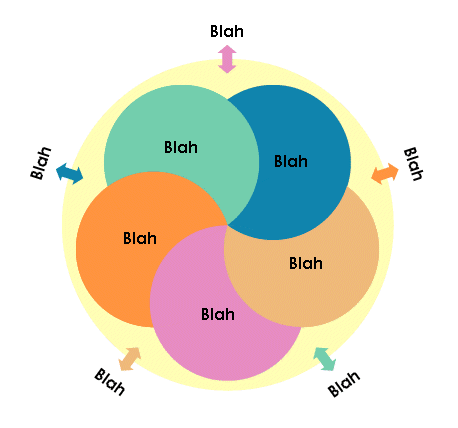
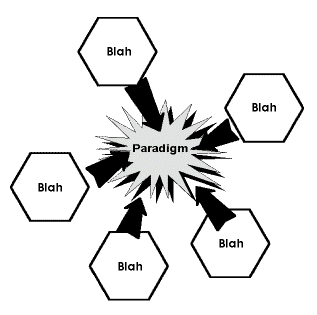
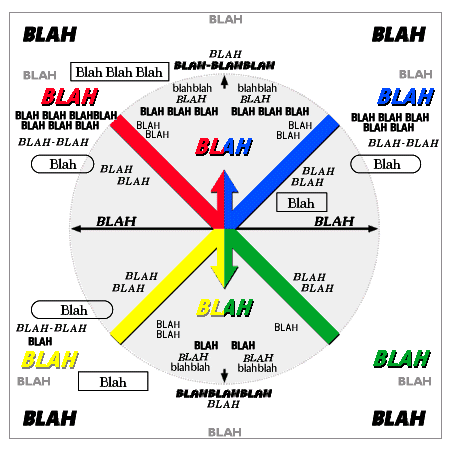
As promised, more GIFs from the mysterious http://castlezzt.net (caution: massive page load).
I hear the second night of "Low Level Allstars" (Thursday Feb 24) at Deitch was better than Wednesday, the night I attended [or I should say even better, since Wednesday was great]. I'm told the sound guy improved (I can attest that he did a not-so-good job the first night), and the speakers were put on tall stands. Also the crowd was bigger and more polite, although according to one report people were sitting down during Bodenstandig, which was definitely an up on your feet partying kind of thing. It's hard to find the right balance between sitting, listening, and partying, especially when trying to manage a typical New York gallery audience of people there to make the scene, yak, and network for their all-important careers.
For an example of what I'm talking about, check out the .mp3 of this John Parker/jenghizkhan performance at the Front Room in Brooklyn. He's playing some great gritty electro-noise stuff and you can hear the schmoozers just schmoozing away. This is no comment on his music--it doesn't matter who's playing here, music and performance are just a sort of background for everyone's personal movie. As I've mentioned before, this is partly because New York has an embarrassment of riches relative to other scenes and people are just blase, but there is also a high oink factor.
In the comments to my second post on Bodenstandig, Jonathan Brodsky floats the theory that jungle (the older, purer version of drum and bass) was the product of open source software, as opposed to musicians using commercial products. Let's nip that meme right here! Here's Brodsky's comment:
I don't know about jungle originating in commercial software environs... It was my understanding that the form developed in trackers similar to the ones that bodenstandig uses, on the amiga. I know that the breakcore sound is mostly due to the tracker interface as well. which software were you thinking was the one that spawned jungle?I clarified that by "commercial software environment" I also mean to include software in so-called hardware synths and samplers, and further replied:
Rob Playford initially used a shareware sequencer called Superconductor (running on an Atari) along with an Akai S-950 sampler and DAT, around the time of 2 Bad Mice's "Waremouse." By 1993 he'd switched to C-Lab's Notator, a commercial product. (C-Lab eventually became Emagic, maker of the popular sequencer Logic.) The real breakthrough for jungle came not so much with tracking, or sequencing, as abuse of (commercial) samplers. From The Mix (1996): "[Metalheadz'] 'Terminator' tore through the scene [in '93] with a vengeance ... its manipulation of timestretching from a sampling utility into a revolutionary new sound effect (by pushing the circuitry way beyond its parameters) made 'Terminator' not just a big tune, but a seminal one for the emerging and, by this time, identifiable new scene."
